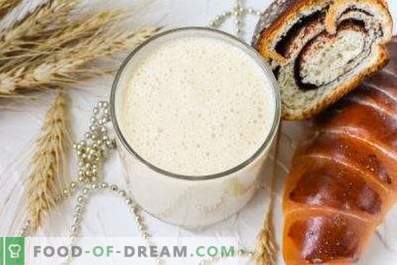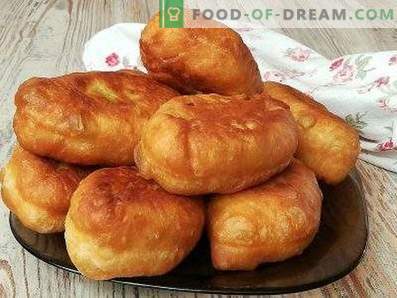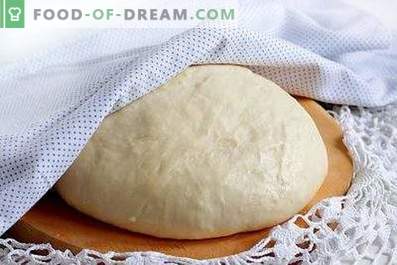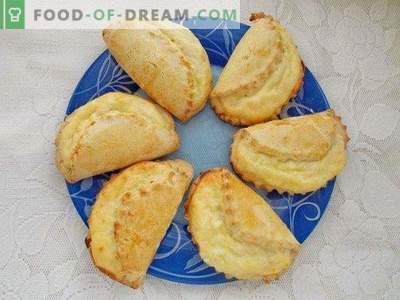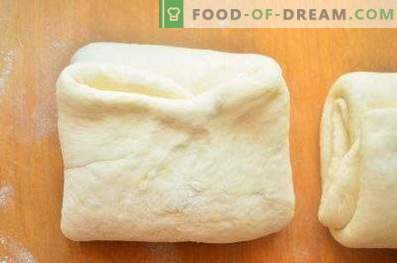
Few housewives bake bread at home, although earlier our ancestors did it themselves. From television programs, we know that not all bakery manufacturers relate to work in good faith. Wanting to reduce the cost of products and get higher profits, they use low-quality products to make dough. Loaves baked from it and loaves not only have a specific flavor and unappetizing appearance, but are not too beneficial for the organism. If your family respects the bread and wants the fresh loaf to be always on the table, you should learn how to bake it at home. The presence of a bread machine in the house will simplify the task, but you can do without it. The main thing is to knead a good dough for bread, then it will turn out lush, appetizing, tasty.
Cooking Features
There are several moments, without the knowledge of which it is impossible to knead the dough for bread at home and make a tasty loaf, loaf or loaf from it.
- Delicious and beautiful bread is made only from high-grade flour. If you use second-grade flour for it, it will be no better for you than the cheapest shop.
- Bread is not only wheat, it can be made from flour from different cereals, but wheat flour must still be present in the composition. No other flour contains as much gluten as it does. From only rye flour to bake bread will not work.
- Sifting flour before kneading dough is a mandatory procedure. If you want to get a lush loaf, it will not hurt you to sift the flour even twice or thrice. The purpose of this manipulation is not only to get the product out of small litter and flour moth larvae. The main task is to saturate it with oxygen. After sifting flour becomes light, it easily combines with other ingredients, without forming lumps. Bread from such flour turns out gentle and air. The dough made from it rises better and faster than from whole grain.
- When kneading dough on bread with your hands, it is important to overcome the temptation to add flour so that it stops sticking to your hands and the table. If the recipe is complied with, then the dough, saturated with air in the process of kneading, will no longer stick to the hands and the table top. If the table and hands are often sprinkled with flour in the process of kneading dough so that the dough does not stick to them, it will get too much flour, it will become excessively dense, the bread made from it will seem to you not sufficiently lush. Flour can be poured only in the formation of loaf dough or other products.
- Knead the dough onto the bread with your hands. It is possible to resort to the help of a mixer or a food processor only at the first stage of mixing the ingredients. To do this, choose a special nozzle for the test. Only a bread machine can be entrusted with the process of kneading dough on bread completely.
- Knead the dough with your hands for a long time, but gently. It can not be strongly knead or beat. With the dough, knead on the bread, you need to handle carefully and gently. Then the bread itself will be tender and lush.
- If you follow the classical technology of making bread, the dough for it should be put on the lees. You can use both pressed and dry yeast. Dilute them with warm liquid. Its optimum temperature is about 35 degrees. You should not risk and pour yeast with liquid more hot than 40 degrees - it will kill them. In a cold environment, yeast simply does not work. In rare cases, bread is baked from unleavened dough, it turns out a little less fluffy, but also tasty.
- Before being placed in an oven, a loaf formed from yeast dough should be allowed to separate. If it has increased in volume and, after lightly pressing it with a finger, it quickly takes on its former shape, it can already be placed in a preheated oven and baked.
Bread should be baked at the maximum temperature in the oven (at least 230 degrees). Baking time depends on the size of the loaf. Usually, it takes half an hour to prepare a loaf weighing 0.5 kg, a loaf weighing 1 kg is cooked for 45-50 minutes, and with more weight of bread it will take at least an hour to bake.
Simple dough recipe for wheat bread
Composition:
- wheat flour - 0.5 kg;
- water - 0, 35 l;
- salt - 10 g;
- sugar - 10 g;
- pressed yeast - 10 g.
Method of preparation:
- Sift flour.
- Crumble yeast on it.
- Pound the yeast with flour with your fingers before turning them into flour crumbs.
- Boil water, dissolve salt and sugar in it. Wait until the water has cooled to 35 degrees.
- Pour water into a bowl of flour.
- Stir the products from the edges towards the center with a spatula, gradually rotating the bowl counterclockwise.
- Put the dough on the table, even though it is still sticky. Take the dough with your hands from one edge and lift it. Shake your hands up from yourself, then down towards you, as a result the bottom of the test should turn up.
- Continue kneading the dough in this way until the dough is no longer sticky.
- Sprinkle flour on the table, put dough on it. Tightening the edges of the dough to the center and pressing them tightly, form a ball.
- Grease a bowl of vegetable oil so that the dough does not stick to it. Put the dough ball in the bowl. Tighten the bowl with cling film, put in a warm place.
In about an hour and a half, the dough will rise, increasing in volume by 2 times. After that, you can gently knead and leave until re-raising or immediately used for making bread.
Dough for rye bread
Composition:
- wheat flour of the highest grade - 0, 25 kg;
- rye flour - 0, 25 kg;
- kefir or yogurt - 0, 25 l;
- sugar - 20 g;
- salt - 20 g;
- pressed yeast - 20 g;
- refined vegetable oil - 20 ml.
Method of preparation:
- Heat sour milk to 30-35 degrees. It is better to do this on the steam bath so that the fermented milk product is not divided into cottage cheese and whey.
- Pour the yogurt into a bowl, crumble the yeast into it. Mash the yeast with a spoon and mix with the fermented milk product.
- Put sugar and salt in yogurt, mix it well again.
- Cover the bowl with the starter cling film and leave for about an hour in a warm place.
- Add oil to the brew, mix.
- Sift both types of flour, put them together and sift again.
- Gradually add the flour mixture to the liquid base. After adding the new portion of flour, stir the dough until smooth, to prevent the formation of lumps.
- When the dough is sufficiently dense, lay it on the working surface of the table and complete the kneading process with your hands. You can stop kneading dough only after it stops sticking to your hands.
- Form a ball out of dough, put it in a pan, cover with a damp towel, leave for about 2 hours in a warm place.
- Punch dough, poke it with your fingers, make a loaf of it or give it a different shape.
- Cover with a towel and leave for 30-40 minutes for proofing.
After the specified time, bread can be sent to an oven heated to 230-250 degrees and baked until ready.
The easiest recipe for bread dough in a bread maker
Composition:
- wheat flour - 0, 4 kg;
- water - 0, 25 l;
- salt - 5 g;
- sugar - 5 g;
- dry yeast - 5 g.
Method of preparation:
- Sift the flour, put it in the bread machine's bucket, trying to leave free space on one side.
- In flour, make three small pits, pour salt, sugar and yeast into them.
- Heat the water to about 35 degrees, pour it into the container of the device from the side where there is less flour. Make sure that the yeast does not touch the liquid.
- Turn on the unit, installing the program “Bread” or similar, wait for the breadmaker to finish its work.
By analogy with the preparation of bread in a bread maker according to the simplest recipe, you can knead and bake bakery products according to more complex recipes - the principle will be the same.
Dough for sourdough rye bread (without ready-made yeast)
Composition:
- Peeled rye flour - 0, 55 kg;
- wheat flour - 0, 2 kg;
- salt - 10 g;
- water - 0, 4 liters.
Method of preparation:
- Sift rye flour. Separate half a cup, pour into a bowl.
- Heat the water to about 30-40 degrees. Approximately one third of a glass of water should be added to rye flour poured into a bowl. Mix them well.
- Bowl with flour mixed with water, wrap with cling film and leave for 2 days warm at a temperature slightly above room temperature.
- After the indicated time, dissolve half a cup of rye flour again with 80-100 ml of warm water. Add to the first portion of the starter. Stir.
- Leave the leaven for another 2 days under similar conditions.
- Stir the leaven. Remove about half of it. To the rest, add 100 g of wheat flour (pre-sifted) and 60 ml of warm water. Cover with cling film and leave to warm for 2-3 hours.
- After the indicated time, add the remaining rye and wheat flour, water and salt to the dough. Knead the dough.
- Lubricate with vegetable oil the form in which you plan to bake bread.
- Put the dough in the form, smooth it. Leave to part for 1, 5 hours.
To bake bread from the dough prepared according to the above recipe, the oven needs to be heated to 250 degrees and put into it the form with the dough. After 15 minutes, the temperature in the oven should be reduced to 220 degrees and continue to bake a loaf for an hour.
Dough for bran bread without yeast
Composition:
- wheat flour - 0, 6 kg;
- sunflower seeds (peeled) - 50 g;
- oat bran - 50 g;
- salt - 5 g;
- whey - 0, 35 l;
- baking powder for dough - 10 g.
Method of preparation:
- Sift flour.
- Chop the bran with a blender or grinder, mix with flour.
- Pour baking powder and salt into the prepared mixture, mix well.
- Add peeled sunflower seeds. They can be replaced with sesame or flax seeds.
- Stir so that the seeds are distributed evenly in the flour mixture.
- Make a well in the bulk solids mixture. Pour in a slightly heated serum.
- Stir the products with a spatula or mixer with a special nozzle.
- Complete the dough with your hands.
It remains to form small loaves of dough, let them stand for 15-20 minutes and send them to a preheated oven. The supporters of healthy food will like the recipe for this bread dough.
Many people buy bread of dubious quality in the store, not even realizing that it can be made at home, and this task will be no more difficult than making buns, pies and other home-made cakes. The easiest way to knead the dough and bake the bread in the bread maker, but you can do without the help of this unit. The dough for bread can be yeast and unleavened. It can also be made on sourdough from rye flour.








